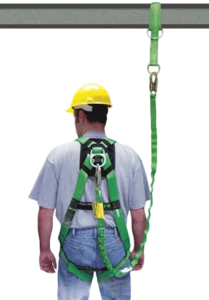FALL PROTECTION EQUIPMENT INSPECTIONS
 I recently assisted a company with their annual fall protection equipment inspections. It was a tedious and monotonous task but well worth it. Throughout the process we removed numerous body harnesses, connectors, self-retracting lifelines, and safety ropes. Each piece of equipment removed from service was a reminder of the importance of the pre-use and annual inspection process. In theory, if users were effectively inspecting the equipment, we would not remove anything from service. Although I am optimistic, I have yet to see this happen.
I recently assisted a company with their annual fall protection equipment inspections. It was a tedious and monotonous task but well worth it. Throughout the process we removed numerous body harnesses, connectors, self-retracting lifelines, and safety ropes. Each piece of equipment removed from service was a reminder of the importance of the pre-use and annual inspection process. In theory, if users were effectively inspecting the equipment, we would not remove anything from service. Although I am optimistic, I have yet to see this happen.
According to the Occupational Safety and Health Administration (OSHA) 1910.140 Personal Fall Protection Systems (General Industry): “Personal fall protection systems must be inspected before initial use during each work shift for mildew, wear, damage, and other deterioration, and defective components must be removed from service.” Similarly, for those in the Construction Industry, OSHA 1926.502 Fall Protection requires that “personal fall arrest systems shall be inspected prior to each use for wear, damage and other deterioration, and defective components shall be removed from service.”
In addition to pre-use inspections, ANSI Z359.1 requires that fall protection, including rescue equipment, be inspected on a regular basis not to exceed one year (or more frequently if required by manufacturer’s instructions) by a competent person or a competent rescuer, as appropriate, to verify that the equipment is safe for use. While ANSI standards are considered voluntary or “best practice” it is strongly recommended that fall protection equipment be inspected at least annually by a competent person. ANSI considers a competent person an individual knowledgeable of fall protection equipment, including manufacturers recommendations and instructions for proper use, inspection, storage, and maintenance. The competent person must also be capable of identifying hazards and have the employer’s authority to take prompt corrective action to the eliminate or control those hazards, and is knowledgeable of the laws, regulations, and standards regarding fall protection equipment and systems.
OSHA does not require documentation of pre-use inspections. Keep in mind that during an inspection an OSHA compliance officer could ask employees about pre-use inspection practices. Many companies choose to document pre-use inspections or incorporate inspections into their daily hazard analysis processes to ensure completion.
As mentioned earlier, annual competent inspections required by the ANSI standard are considered voluntary or “best practice.” It is strongly encouraged that annual competent person inspections be documented in an effective manner. This can be as simple as having the competent person initial and date the equipment’s inspection tag or label. The preferred option would be to also document the inspection to include the name of the inspector, date of the inspection, description of the equipment to include model number and serial number, manufacture, date of manufacture, whether the equipment passed or failed the inspection along with the reason, and the outcome (i.e., removal from service, sent to manufacture for repair, etc.). This option also provides the organization with detailed records and an inventory of equipment currently in service.
A common question around fall protection equipment, particularly body harnesses and connectors, is how long they are good for or whether they expire. OSHA and ANSI do not reference a maximum service life for synthetic fiber products. They do require that the user remove the equipment from service if it has been subjected to the forces associated with arresting a fall. Similarly, both ANSI and OSHA standards reference that when an inspection reveals defects or damage that the equipment be removed from service.
Some manufacturers still define an estimated or recommended service life, usually five years. Many organizations adhere to these recommendations and remove equipment after the five-year service life while others rely on pre-use and annual competent person inspections to determine whether equipment is fit for duty.
When establishing fall protection equipment inspection requirements at your organization, consider requiring an annual competent person inspection along with effective documentation. This will result in the removal of unsafe equipment from the work environment and evaluate the effectiveness of pre-use inspection activities. Remember, safety doesn’t have to be difficult, simple steps, such as incorporating fall protection equipment inspections into daily hazard analysis processes, can prevent injuries and save lives.
Here at Safety Made Simple, our team of safety experts create content and courses that help send your people home safely. Check out our safety scoops newsletter to see some of the topics we cover!
Joe Mlynek is a partner and subject matter expert at Safety Made Simple, LLC. He has over 20 years of experience in safety at the corporate level and as a consultant. He is a Certified Safety Professional (CSP) and Occupational Safety and Health Technician (OHST). Joe can be reached at joe.mlynek@safetymadesimple.com
